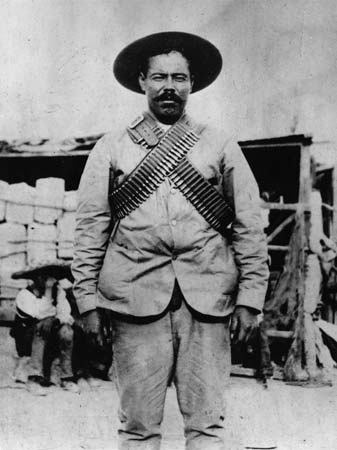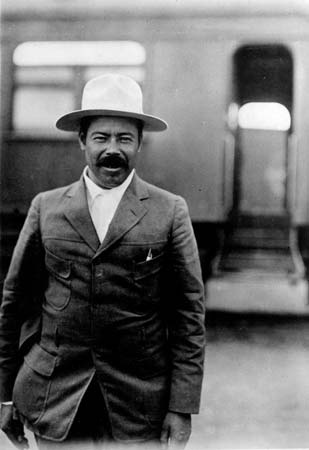Villa, Pancho
Filipino boxer
original name Francisco Guilledo
born Aug. 1, 1901, Iloilo, Phil.
died July 14, 1925, San Francisco, Calif., U.S.
 Filipino professional boxer, world flyweight (112 pounds) champion.
Filipino professional boxer, world flyweight (112 pounds) champion.Villa began his boxing career in 1919, winning various titles in the Philippines. Within a few months of his arrival in the United States, he knocked out the American flyweight champion, Johnny Buff (John Lesky), in the 11th round of a nontitle fight on Sept. 15, 1922. Villa won the world flyweight championship by knocking out Jimmy (“Mighty Atom”) Wilde (Wilde, Jimmy) of Wales in the seventh round on June 18, 1923. He made several title defenses before his last fight, a nontitle bout on July 4, 1925, when he lost a 10-round decision (a fight whose outcome is determined by judges' scoring) to Irish-born Canadian Jimmy McLarnin. Ten days later, Villa died from blood poisoning caused by an infected gum where one of his wisdom teeth had been removed just before the fight. He had a record of 73 wins (22 by knockouts), 5 losses, 4 draws, and 23 no decisions (a common result in boxing's early days). Villa was inducted into the International Boxing Hall of Fame in 1994.
Mexican revolutionary
byname of Francisco Villa, original name Doroteo Arango
born June 5, 1878, Hacienda de Río Grande, San Juan del Río, Mexico
died June 20, 1923, Parral
 Mexican (Mexican Revolution) revolutionary and guerrilla leader, who fought against the regimes of both Porfirio Díaz and Victoriano Huerta and after 1914 engaged in civil war and banditry.
Mexican (Mexican Revolution) revolutionary and guerrilla leader, who fought against the regimes of both Porfirio Díaz and Victoriano Huerta and after 1914 engaged in civil war and banditry.Villa was the son of a field labourer and was orphaned at an early age. In revenge for an assault on his sister, he killed one of the owners of the estate on which he worked and was afterward forced to flee to the mountains, where he spent his adolescence as a fugitive.
In 1909 Villa joined Francisco Madero (Madero, Francisco)'s uprising against the dictator of Mexico, Porfirio Díaz (Díaz, Porfirio). During the rebellion, Villa, who lacked a formal education but had learned to read and write, displayed his talents as soldier and organizer. Combined with his intimate knowledge of the land and the people of northern Mexico, these gifts enabled him to place at Madero's disposal a division of trained soldiers under his command. After the success of the revolution, Villa remained in the irregular army.
 In 1912, during the rebellion of Pascual Orozco, Villa aroused the suspicion of General Victoriano Huerta (Huerta, Victoriano), who condemned him to death, but Madero ordered a stay of execution and sent Villa to prison instead. Villa escaped from prison in November and fled to the United States. After Madero's assassination in 1913, Villa returned to Mexico and formed a military band of several thousand men that became known as the famous División del Norte (Division of the North). Combining his force with that of Venustiano Carranza (Carranza, Venustiano), Villa revolted against the increasingly repressive and inefficient dictatorship of Huerta, once again revealing his military talents by winning several victories. In December 1913 Villa became governor of the state of Chihuahua and with Carranza won a decisive victory over Huerta in June 1914. Together they entered Mexico City as the victorious leaders of a revolution.
In 1912, during the rebellion of Pascual Orozco, Villa aroused the suspicion of General Victoriano Huerta (Huerta, Victoriano), who condemned him to death, but Madero ordered a stay of execution and sent Villa to prison instead. Villa escaped from prison in November and fled to the United States. After Madero's assassination in 1913, Villa returned to Mexico and formed a military band of several thousand men that became known as the famous División del Norte (Division of the North). Combining his force with that of Venustiano Carranza (Carranza, Venustiano), Villa revolted against the increasingly repressive and inefficient dictatorship of Huerta, once again revealing his military talents by winning several victories. In December 1913 Villa became governor of the state of Chihuahua and with Carranza won a decisive victory over Huerta in June 1914. Together they entered Mexico City as the victorious leaders of a revolution.Rivalry between Villa and Carranza, however, soon led to a break between the two, and Villa was forced to flee Mexico City with the revolutionary leader Emiliano Zapata (Zapata, Emiliano) in December 1914. Badly defeated by Carranza in a series of battles, he and Zapata fled to the mountains of the north. But in order to demonstrate that Carranza did not control northern Mexico, Villa executed some 17 U.S. citizens at Santa Isabel in January 1916 and two months later attacked Columbus, New Mexico, killing about 17 Americans. President Woodrow Wilson (Wilson, Woodrow) then sent an expedition under General John J. Pershing (Pershing, John J) to that area, but, because of Villa's popularity and intimate acquaintance with the terrain of northern Mexico and because of the Mexican government's dislike of Pershing's presence on Mexican soil, it proved impossible to capture Villa.
Villa continued his guerrilla activities as long as Carranza remained in power. After the overthrow of Carranza's government in 1920, Villa was granted a pardon and a ranch near Parral, Chihuahua, in return for agreeing to retire from politics. Three years later he was assassinated on his ranch.
- Rosenbach, A S W
- Rosenberg, Alfred
- Rosenberg, Harold
- Rosenberg, Isaac
- Rosenberg, Julius; and Rosenberg, Ethel
- Rosenbusch, Karl Heinrich Ferdinand
- Rosenquist, James
- Rosenwald, Julius
- Rosenzweig, Franz
- rose of Jericho
- Rose of Lima, Saint
- rose of Sharon
- roseola infantum
- Rose O'Neal Greenhow
- Rose, Pete
- rose quartz
- Roses, Wars of the
- Rose Terry Cooke
- Rose Theatre
- Roset, Michel
- Rose Tremain
- Rosetta
- Rosetta Stone
- Roseville
- Rosewall, Ken